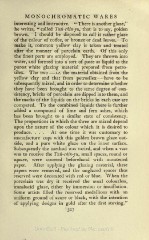Page 401 - Oriental Series Japan and China, Brinkly
P. 401
MONOCHROMATIC WARES
interesting and instructive. " There is another glaze,"
he writes, " called Tzu-chin-yu, that is to say, golden
brown. I should be disposed to call it rather glaze
of the colour of coffee, or bronze or dead leaves. To
make it, common yellow clay is taken and treated
after the manner of porcelain earth. Of this only
the finest parts are employed. They are thrown into
water, and formed into a sort of paste as liquid as the
purest white glazing material prepared from petro-
silex. The two i.e. the material obtained from the
yellow clay and that from petrosilex have to be
subsequently mixed, and in order to determine whether
they have been brought to the same degree of con-
sistency, bricks of porcelain are dipped into them, and
the marks of the liquids on the bricks in each case are
compared. To the combined liquids there is further
added a compound of lime and fern ashes, which
has been brought to a similar state of consistency.
The proportions in which the three are mixed depend
upon the nature of the colour which it is desired to
produce. ... At one time it was customary to
manufacture cups with this golden brown glaze out-
side, and a pure white glaze on the inner surface.
Subsequently the method was varied, and when a vase
was to receive the Tzu-chin-yu, small spaces, round or
square, were covered beforehand with moistened
paper. After applying the glazing material, these
papers were removed, and the unglazed spaces thus
reserved were decorated with red or blue. When the
porcelain was dry it received the usual colourless,
translucid glaze, either by immersion or insufflation.
Some artists filled the reserved medallions with an
uniform ground of azure or black, with the intention
of applying designs in gold after the first stoving."
3 27

